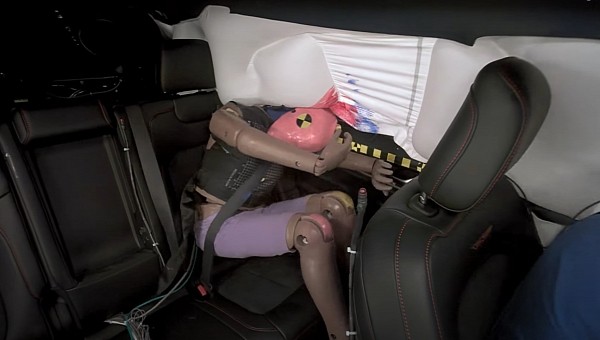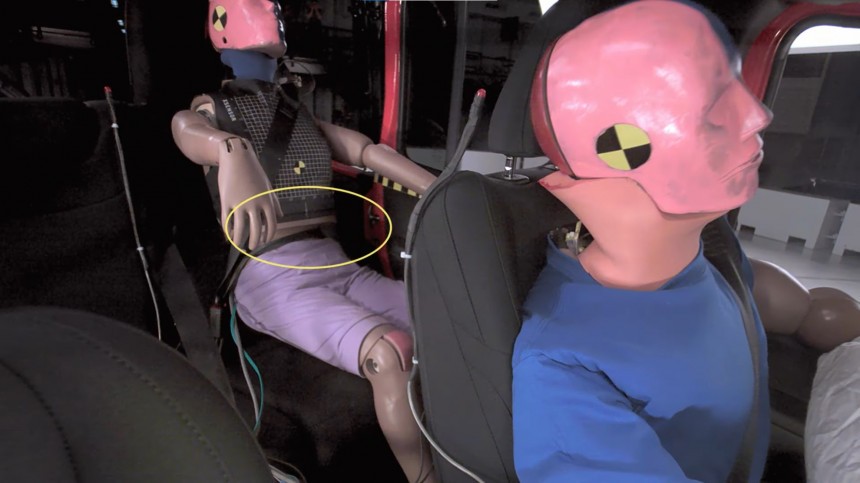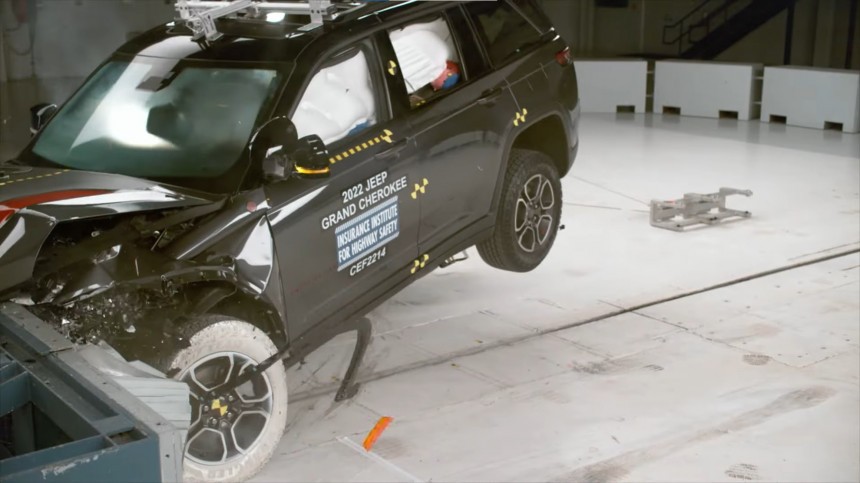The latest crash test ratings from IIHS (Insurance Institute for Highway Safety) show that some midsize SUVs do not offer adequate protection for rear passengers. The organization recently updated its moderate overlap front crash test by adding a passenger dummy behind the driver, and it has tested 13 midsize SUVs. Before revealing the results, let me tell you more about the new rear passenger test.
A driver dummy is still present, but the main differentiator between vehicles in these overlap front crash tests is the rear passenger protection. Given that our friends and family usually ride in the backseat, we should place more emphasis on their safety. In vehicles from 2007 onward, there’s a 46% higher risk for a fatal injury for belted occupants in the rear seat compared to the front. The main reason for this statistic is that restraint technologies have only improved in the front seat.
Consequently, IIHS updated the moderate overlap front test last year in response to research showing that recent safety gains only happened for front seats. The new test uses a Hybrid III dummy representing a small woman or a 12-year-old child in the second row behind the driver. Furthermore, it utilizes metrics centered around the injuries usually seen in rear-seat occupants.
So, how can a vehicle obtain a good score? First of all, the sensors in the second-row dummies must record measurements beneath the limit of an excessive risk to the head, neck, chest, abdomen, or thigh, and there’s a separate rating for each of these body parts. Moreover, the grease paint applied to the dummy’s head and video footage must prove that the vehicle restraints successfully prevented the head from hitting the interior or even coming too close to the front seatback.
A pressure sensor monitors the position of the shoulder belt on the torso and can gauge the risk of chest injuries. There’s also the “submarining” effect, in which the dummy can slide beneath the lap belt. In this scenario, the impact can cause abdominal injuries.
Needless to say, the structure of the occupant compartment must leave enough survival space for the driver, and measurement from the driver dummy shouldn’t show signs of excessive risk of injuries.
Out of the 13 midsize SUVs tested, only four earned good ratings: the Ford Explorer, Ford Mustang Mach-E, Subaru Ascent, and Tesla Model Y. By most metrics, they offered solid protection for rear passengers. Specifically, the seat belt remained adequately positioned, the side curtain airbag fulfilled its purpose, and no excessive force was placed on the dummy’s chest.
However, in the case of the Ascent and the Explorer, there was a slight risk of head or neck injuries. Furthermore, the rear dummy’s head approached the front seatback in the Model Y.
Three SUVs got marginal ratings regarding passenger safety: the Chevrolet Traverse, Toyota Highlander, and Volkswagen Atlas. In the Atlas and Highlander, the rear passengers’ risk of head or neck injuries was slightly higher than in the Traverse. Furthermore, the seat belt tension was high in the Atlas and Traverse, and in the Atlas, the rear dummy’s head came close to the front seatback. Lastly, the seat belt moved from the ideal position to the abdomen in the Highlander.
The remaining six SUVs were poorly rated: the Honda Pilot, Hyundai Palisade, Jeep Grand Cherokee, Jeep Wrangler 4-door, Mazda CX-9, and Nissan Murano. There was a high risk of head or neck injuries to the rear passenger in the CX-9, Grand Cherokee, Murano, Palisade, and Pilot, and a significant risk in the Wrangler. What’s more, the Wrangler doesn’t have a side curtain airbag in the rear, and the lap belt moved from the ideal position.
There was a high risk for chest injury in the CX-9, Grand Cherokee, Palisade, and Pilot. Moreover, in the Murano, the rear passenger dummy came close to hitting the front setback. But the least desirable result regarding head injury was for the Grand Cherokee, where the dummy’s head ended up between the window and the airbag after rebounding from the initial impact. Of course, that means passengers are susceptible to injuries from hitting the vehicle’s hard surfaces or other objects inside the car.
As expected, all 13 SUVs performed well according to the original front seat criteria. However, not all of them were flawless – for instance, in the Atlas, there was a significant risk of injuries to the driver’s right leg. In the Traverse, the airbag didn’t help much, as the dummy’s head still hit the steering wheel hard. Lastly, the driver’s side airbag did not deploy in the Wrangler.
Organizations such as the IIHS and Euro NCAP must establish strict testing conditions and regulations to ensure the safety of all occupants, whether drivers or passengers. IIHS’s recent changes are a significant step in the right direction. They will surely push automakers to make the necessary adjustments regarding their vehicles’ design and safety.
Consequently, IIHS updated the moderate overlap front test last year in response to research showing that recent safety gains only happened for front seats. The new test uses a Hybrid III dummy representing a small woman or a 12-year-old child in the second row behind the driver. Furthermore, it utilizes metrics centered around the injuries usually seen in rear-seat occupants.
So, how can a vehicle obtain a good score? First of all, the sensors in the second-row dummies must record measurements beneath the limit of an excessive risk to the head, neck, chest, abdomen, or thigh, and there’s a separate rating for each of these body parts. Moreover, the grease paint applied to the dummy’s head and video footage must prove that the vehicle restraints successfully prevented the head from hitting the interior or even coming too close to the front seatback.
A pressure sensor monitors the position of the shoulder belt on the torso and can gauge the risk of chest injuries. There’s also the “submarining” effect, in which the dummy can slide beneath the lap belt. In this scenario, the impact can cause abdominal injuries.
Out of the 13 midsize SUVs tested, only four earned good ratings: the Ford Explorer, Ford Mustang Mach-E, Subaru Ascent, and Tesla Model Y. By most metrics, they offered solid protection for rear passengers. Specifically, the seat belt remained adequately positioned, the side curtain airbag fulfilled its purpose, and no excessive force was placed on the dummy’s chest.
However, in the case of the Ascent and the Explorer, there was a slight risk of head or neck injuries. Furthermore, the rear dummy’s head approached the front seatback in the Model Y.
Three SUVs got marginal ratings regarding passenger safety: the Chevrolet Traverse, Toyota Highlander, and Volkswagen Atlas. In the Atlas and Highlander, the rear passengers’ risk of head or neck injuries was slightly higher than in the Traverse. Furthermore, the seat belt tension was high in the Atlas and Traverse, and in the Atlas, the rear dummy’s head came close to the front seatback. Lastly, the seat belt moved from the ideal position to the abdomen in the Highlander.
There was a high risk for chest injury in the CX-9, Grand Cherokee, Palisade, and Pilot. Moreover, in the Murano, the rear passenger dummy came close to hitting the front setback. But the least desirable result regarding head injury was for the Grand Cherokee, where the dummy’s head ended up between the window and the airbag after rebounding from the initial impact. Of course, that means passengers are susceptible to injuries from hitting the vehicle’s hard surfaces or other objects inside the car.
As expected, all 13 SUVs performed well according to the original front seat criteria. However, not all of them were flawless – for instance, in the Atlas, there was a significant risk of injuries to the driver’s right leg. In the Traverse, the airbag didn’t help much, as the dummy’s head still hit the steering wheel hard. Lastly, the driver’s side airbag did not deploy in the Wrangler.
Organizations such as the IIHS and Euro NCAP must establish strict testing conditions and regulations to ensure the safety of all occupants, whether drivers or passengers. IIHS’s recent changes are a significant step in the right direction. They will surely push automakers to make the necessary adjustments regarding their vehicles’ design and safety.












